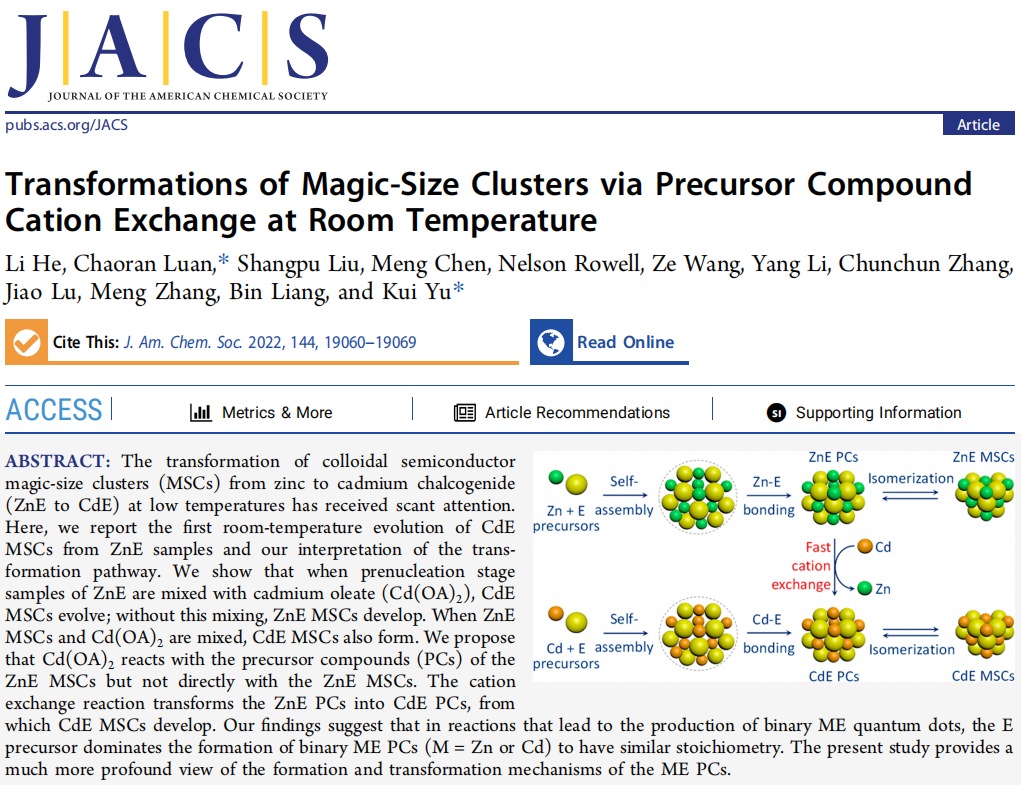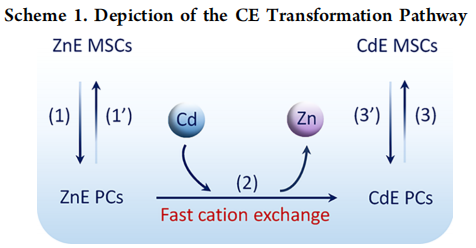
The research team of Professor Kui Yu from theEngineering Research Center in Biomaterials/Institute of Atomic and Molecular Physics, Sichuan Universityhas been working for five years on room temperature cation exchange from binary ZnE magic clusters to CdE magic clusters. The research findings were recently published under the title "Transformations of Magic-Size Clusters via Precursor Compound Cation Exchange at Room Temperature” in J. Am. Chem. Soc., an authoritative magazine in the field of Chemistry. The first author of the paper is Li He, a doctoral student of theEngineering Research Center in Biomaterials. Prof. Kui Yu and Dr. Chaoran Luan are the co corresponding authors, and SCU is the first work unit of the thesis.

“The transformation of colloidal semiconductor magic-size clusters (MSCs) from zinc to cadmium chalcogenide (ZnE to CdE) at low temperatures has received scant attention. Here, we report the first room-temperature evolution of CdE MSCs from ZnE samples and our interpretation of the transformation pathway. We show that when prenucleation stage samples of ZnE are mixed with cadmium oleate (Cd(OA)2), CdE MSCs evolve; without this mixing, ZnE MSCs develop. When ZnE MSCs and Cd(OA)2 are mixed, CdE MSCs also form. We propose that Cd(OA)2 reacts with the precursor compounds (PCs) of the ZnE MSCs but not directly with the ZnE MSCs. The cation exchange reaction transforms the ZnE PCs into CdE PCs, from which CdE MSCs develop. Our findings suggest that in reactions that lead to the production of binary ME quantum dots, the E precursor dominates the formation of binary ME PCs (M = Zn or Cd) to have similar stoichiometry. The present study provides a much more profound view of the formation and transformation mechanisms of the ME PCs.” (Abstract)
The team has published more than 40 papers on PCs (precursor compounds), and has gradually constructed isomerization reaction (Nat. Commun. 2018, 9, 2499; 2020, 11, 4199), replacement reaction (Nat. Commun. 2019, 10, 1674; Angelw. 2020, 59, 16943; 2022, e20214551; e202205784), decomposition reaction (Angelw. 2020, 59, 12013; 2022, e202209615), addition reaction (Angelw. 2021, 60, 20358) and cation exchange reaction (JACS 2022, 144, 19060). The continuous accumulation of the above theoretical models and experimental results are expected to help nano synthetic chemistry rise from the stage of relying on the experience of "craftsmanship" to an independent discipline, promote the scientific and accurate development of discipline-related concept systems, and achieve a major breakthrough in the discipline from 0 to 1.
Nature Reviews Materials (2022, 7, 596-596), a top international journal for materials science, reported on the team's PC research. Zhongfan Liu (academician of the CAS) also spoke highly of the team's scientific research achievements in Acta Phys. - Chim. Sin. 2019, 35, 451 – 452; 2020, 36, 2005052; 2021, 37, 2008014), and affirmed the scientific theory, breakthrough and cutting-edge of the "Yu's dual path model".
https://pubs.acs.org/doi/10.1021/jas.2c07972
